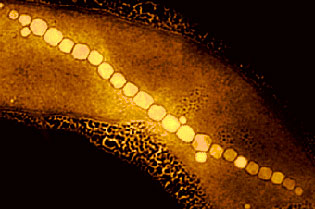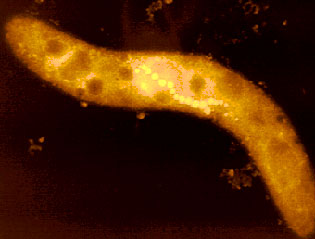Amy’s magnetic field
Fri, 28 Sep 2012 13:07:00 BST
Researcher aims to understand one of nature’s strangest secrets
 HER studies for a doctorate at the University of Huddersfield are enabling Amy Monnington (pictured) to make a key contribution to research that will unlock the understanding of one of the most intriguing processes in nature.
HER studies for a doctorate at the University of Huddersfield are enabling Amy Monnington (pictured) to make a key contribution to research that will unlock the understanding of one of the most intriguing processes in nature.
Magnetotactic bacteria are organisms which develop membrane-encapsulated nano-particles known as magnetosomes. Magnetosomes allow bacteria to orient themselves along the earth’s magnetic field lines in order to migrate to more favourable environments.
Magnetosomes contain the iron-oxygen composite, magnetite, which is also found in more complex organisms, such as honey bees, salmon and pigeons, and presumed to play a key role in navigation.
Although magnetotactic bacteria (seen below) were first discovered in 1975, the production of their magnetite crystals is still not fully understood.
 Now, the Department of Chemical and Biological Sciences at the University of Huddersfield is working on a project which aims for greater understanding of magnetite formation. It is the basis of Amy Monnington’s PhD thesis and the project, supervised by Dr David Cooke.
Now, the Department of Chemical and Biological Sciences at the University of Huddersfield is working on a project which aims for greater understanding of magnetite formation. It is the basis of Amy Monnington’s PhD thesis and the project, supervised by Dr David Cooke.
Although she is a chemist by background, Amy’s research takes place not in a laboratory, but at a computer terminal. Corroborators at the University of Leeds are carrying out experimental work in the lab, but nowadays computational simulation is highly complementary to this kind of research and has been proved to be just as important, according to Amy.
She recently presented a paper – Understanding the Biomineralisation of Magnetite within Magnetotactic Bacteria – at the CCP5 Conference that took place at the University of Huddersfield. The meeting brought together a large number of global experts in computational simulation of liquids and solids through a Collaborative Computational Project.
 Amy embarked on her PhD directly after completing her BSc degree in Forensic and Analytic Science at the University of Huddersfield. Dr Cooke – co-organiser of the CCP5 Conference – had been her dissertation supervisor for a forensic project dealing with bullet trajectory and this introduced her to computational science for the first time. After graduation she was invited to join the biomineralisation research project.
Amy embarked on her PhD directly after completing her BSc degree in Forensic and Analytic Science at the University of Huddersfield. Dr Cooke – co-organiser of the CCP5 Conference – had been her dissertation supervisor for a forensic project dealing with bullet trajectory and this introduced her to computational science for the first time. After graduation she was invited to join the biomineralisation research project.
Its original contribution is to discover how magnetite crystals form within magnetotactic bacteria, with the ultimate aim of understanding biomineralisation processes as a whole to enable commercial production of magnetite and other biominerals.
Numerous commercial applications for magnetite nano-particles have previously been considered, with their use as contrast agents for MRI and tumour specific drug carriers in development.
However, such applications are not commercially viable at present, says Amy.
“This is because the mechanisms of biomineralisation are not completely known, thus the production of magnetite on an industrial scale is time-consuming and costly,” she explains.
“We are trying to understand the processes in order to be able to produce the particles more economically.”







